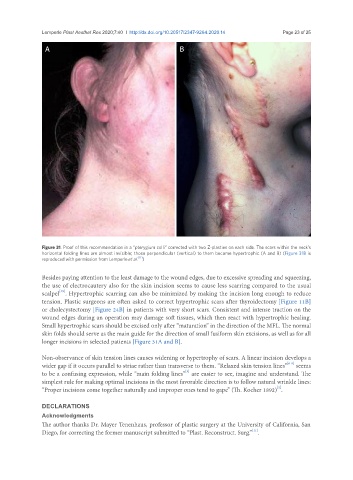Page 454 - Read Online
P. 454
Lemperle Plast Aesthet Res 2020;7:40 I http://dx.doi.org/10.20517/2347-9264.2020.14 Page 23 of 25
A B
Figure 31. Proof of this recommendation in a “pterygium colli” corrected with two Z-plasties on each side. The scars within the neck’s
horizontal folding lines are almost invisible; those perpendicular (vertical) to them became hypertrophic (A and B) (Figure 31B is
[11]
reproduced with permission from Lemperle et al. )
Besides paying attention to the least damage to the wound edges, due to excessive spreading and squeezing,
the use of electrocautery also for the skin incision seems to cause less scarring compared to the usual
[45]
scalpel . Hypertrophic scarring can also be minimized by making the incision long enough to reduce
tension. Plastic surgeons are often asked to correct hypertrophic scars after thyroidectomy [Figure 11B]
or cholecystectomy [Figure 24B] in patients with very short scars. Consistent and intense traction on the
wound edges during an operation may damage soft tissues, which then react with hypertrophic healing.
Small hypertrophic scars should be excised only after “maturation” in the direction of the MFL. The normal
skin folds should serve as the main guide for the direction of small fusiform skin excisions, as well as for all
longer incisions in selected patients [Figure 31A and B].
Non-observance of skin tension lines causes widening or hypertrophy of scars. A linear incision develops a
[6-8]
wider gap if it occurs parallel to striae rather than transverse to them. “Relaxed skin tension lines” seems
to be a confusing expression, while “main folding lines” are easier to see, imagine and understand. The
[3]
simplest rule for making optimal incisions in the most favorable direction is to follow natural wrinkle lines:
[2]
“Proper incisions come together naturally and improper ones tend to gape” (Th. Kocher 1892) .
DECLARATIONS
Acknowledgments
The author thanks Dr. Mayer Tenenhaus, professor of plastic surgery at the University of California, San
Diego, for correcting the former manuscript submitted to “Plast. Reconstruct. Surg.” .
[11]

